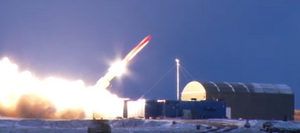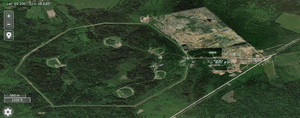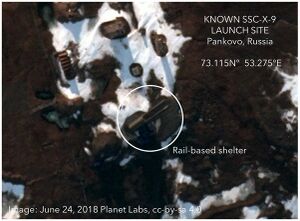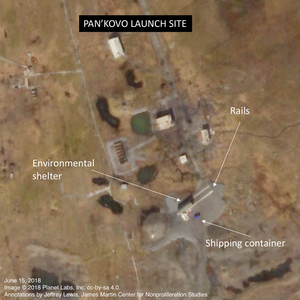9M730 بوريڤستنيك
| 9M730 Burevestnik | |
|---|---|
 9M730 Burevestnik launch test on 1 March 2018 | |
| النوع | Nuclear-powered cruise missile |
| مكان الأصل | Russia |
| تاريخ الخدمة | |
| في الخدمة | Under development |
| المواصفات | |
| الطول | 12 m[1] |
| Effective firing range | Effectively unlimited (due to nuclear powering) |
| الرأس الحربي | Thermonuclear |
The 9M730 Burevestnik (روسية: Буревестник; "Storm petrel", NATO reporting name: SSC-X-9 Skyfall)[2][3][4] is a Russian low-flying, nuclear-powered, nuclear-armed cruise missile under development for the Russian Armed Forces.[2] According to the Russian Ministry of Defense, the missile's range is effectively unlimited.[5][6]
The Burevestnik is one of the six new Russian strategic weapons unveiled by Russian President Vladimir Putin on 1 March 2018.[4][7] This effort bears similarity to the discontinued US Project Pluto from 1957, which although functional, was perceived as too provocative, less effective than ICBMs, and presented radiological emissions that made scheduling test flights difficult.[8]
The missile flew 14,000 kilometers in a 15 hours flight on 21 October 2025, according to Russian Chief of the General Staff Valery Gerasimov.[9]
History
Motivation
A cruise missile has the advantage over a ballistic missile of being maneuvrable and able to fly under and around missile defense radars and interceptors.[10] However, conventional rocket-propelled missiles have a limited flight time and range. Power from nuclear fission offers far more energy from a given mass of fuel which, if it could be used for propulsion, would hypothetically allow a missile to be launched far outside the defensive zone of a target, to take a circuitous route that avoids defenses, and to loiter for an extended period. The United States developed a SLAM nuclear-powered cruise missile during the 1950s, achieving successful full-power testing of Tory II-A and -C, but abandoned the project, in part due to the radioactive pollution produced by deployment.
التطوير
The Russian defense industry began developing an intercontinental-range nuclear-powered cruise missile capable of penetrating any interceptor-based missile defense system in December 2001, after the USA abandoned the 1972 Anti-Ballistic Missile Treaty.[11] According to Professor Mark Galeotti, this missile is a revived project from the Soviet times.[12] It is said to have unlimited range and to be able to evade missile defenses.[5] Russian news agency TASS reported in February 2019 that Burevestnik's nuclear power unit had been tested successfully.[13]
According to a Russian newspaper, the missile was developed by All-Russian Scientific Research Institute of Experimental Physics in Sarov, and it is manufactured by NPO Novator in Yekaterinburg.[14]. According to another Russian newspaper, "Burevestnik" will be adopted by the Russian military no sooner than 2027. It's adoption will not violate the terms of New START Treaty, which Russia suspended (but did not leave) on February 2023-02-21.[15].
The cruise missile was named Burevestnik (Storm petrel, a seabird) as a result of an open vote on the Ministry of Defence of Russia's website.[16][17]
On 5 October 2023, Russian president Vladimir Putin claimed that the missile had been successfully flight-tested, though Western media sources such as the BBC cast doubt on this claim, noting that there was no independent confirmation.[18][19][20] According to the Nuclear Threat Initiative (NTI) in 2024, an advocacy group focused on reducing nuclear, biological and emergent technology risks, "The Burevestnik has a poor test record of at least 13 known tests, with only two partial successes, since 2016".[21]
According to US researchers Decker Eveleth and Jeffrey Lewis, based on imagery analysis of 2024 launch pad construction and storage facilities, the probable deployment site for the Burevestnik is Vologda-20 located 15 km southwest of Chebsara, around 475 km (295 mi) north of Moscow.[21]
Russian Chief of General Staff General Valery Gerasimov said that Burevestnik—with a claimed range between 10,000 and 20,000km, and able to fly as low as 50m above ground—had carried out a 14,000km flight over 15 hours on 21 October 2025, with vertical and horizontal manoevreing tested and found to meet specifications, demonstrating "high capabilities to bypass missile and air defence systems".[22]
Design speculation
According to Vladimir Putin and the Russian Ministry of Defense, the missile's dimensions are comparable to the Kh-101 cruise missile, but the claimed operational range is orders of magnitude greater. It is equipped with a small-sized nuclear power unit. An official presentation shows that the missile starts from an inclined launcher using a detachable rocket booster.[23]
Pavel Ivanov from VPK-news states that the cruise missile is one and a half to two times the size of the Kh-101, and the wings of the Burevestnik are rooted "on top of the fuselage, rather than below it like on the Kh-101." He also notes that there are "characteristic protrusions where air is most likely heated by the nuclear reactor". According to Ivanov, the mass of the Burevestnik is several times, and probably an order of magnitude [10 times] greater than that of the Kh-101, which eliminates the Tu-160 and Tu-95 aircraft as potential carriers of the missile.[24]
According to Nezavisimaya Gazeta, Burevestnik is a nuclear thermal rocket with a solid-fueled booster engine. The length of the missile is 12 m (39 ft) at launch and 9 m (30 ft) in flight. The nose has the shape of an "ellipse 1 m (3.3 ft) × 1.5 m (4.9 ft) in size".[25]
Military expert Anton Lavrov, in an Izvestia article, suggested that the Burevestnik uses a ramjet engine, which, unlike usual nuclear weapon propulsion systems, constantly emits radioactive exhaust.[26]
Stratfor, an American geopolitical intelligence platform, assumes that Burevestnik utilizes a turbojet engine and a liquid-fueled booster.[27]
According to James Hockenhull, the UK's Chief of Defence Intelligence (CDI), the Burevestnik is a "sub-sonic nuclear-powered cruise missile system which has global reach and would allow attack from unexpected directions", and would have "a near indefinite loiter time".[28]
Director of the Federation of American Scientists's Nuclear Information Project Hans M. Kristensen points out that the Burevestnik will be as vulnerable as any cruise missile, and questions the motive behind it, since the longer it flies the more time there is to track it.[21]
Former Los Alamos National Laboratory nuclear researcher Cheryl Rofer and former top State Department official with the Arms Control Association Thomas Countryman have both pointed out the risk of nuclear contamination to Russia itself, with Countryman calling the weapon system "uniquely stupid" and calling it a "flying Chernobyl".[21]
Test locations
Nuclear nonproliferation expert Jeffrey Lewis has identified some likely test locations for the Burevestnik. These locations share a rail-based environmental shelter visible on satellite imagery.
Pan'kovo
The Pan'kovo test range is located 170 km north of Rogachevo air base on Yuzhny Island of the Novaya Zemlya archipelago in the Arctic Ocean.
In November 2017 the site saw an unsuccessful test of a Burevestnik missile that after two minutes of flight that covered some 35 km crashed into the Barents Sea.[29] Three vessels, one of which was equipped to handle radioactive material, were tasked with the recovery of debris from the missile.[30]
Planet Labs satellite imagery from 15 and 24 June 2018 published by Lewis and MIIS show the rail-based environmental shelter at the Pan'kovo test range that is claimed by Lewis to be characteristic of a Burevestnik launch site.[31][29]
Planet Labs satellite imagery from 7 August 2025 published by Lewis and MIIS was claimed by Lewis and by ICBM researcher Decker Eveleth to show test preparations of the Burevestnik at the Pan'kovo test range.[32][33]
The State Central Navy Testing Range is located near Nyonoksa near Severodvinsk in northern Russia.
Airbus satellite imagery from 14 May 2019 published by Lewis shows the rail-based environmental shelter associated with Burevestnik testing at the State Central Navy Testing Range.[31]
Nyonoksa radiation accident
On 9 August 2019, the Russian nuclear energy agency Rosatom confirmed a release of radioactivity at the State Central Navy Testing Range and stated it was linked to an accident involving the test of an "isotope power source for a liquid-fuelled rocket engine".[34][35] Five weapons scientists were killed in the accident.[36] Nonproliferation expert Jeffrey Lewis and Federation of American Scientists fellow Ankit Panda suspect the incident resulted from a test of the Burevestnik cruise missile.[37] However, other arms control experts disputed the assertions: Ian Williams of the Center for Strategic and International Studies and James Acton of the Carnegie Endowment for International Peace expressed skepticism over Moscow's financial and technical capabilities to field the weapon,[38] while Michael Kofman of the Wilson Center concluded that the explosion was probably not related to Burevestnik but instead to the testing of another military platform.[39]
According to CNBC, the explosion occurred during an attempt to recover a missile from the seabed, which was lost during a previously failed test.[40] On 10 October, Thomas DiNanno, member of the United States delegation to the United Nations General Assembly First Committee, stated that the "August 8th 'Skyfall' incident [...] was the result of a nuclear reaction that occurred during the recovery of a Russian nuclear-powered cruise missile", which "remained on the bed of the White Sea since its failed test early last year".[41]
On 26 August 2019, Aleksei Karpov, Russia's envoy to international organizations in Vienna, stated that the accident was linked to the development of weapons which Russia had to begin creating as "one of the tit-for-tat measures in the wake of the United States' withdrawal from the Anti-Ballistic Missile Treaty".[42]
On 21 November 2019, at the ceremony of presentation of posthumous awards to the dead men's families, Vladimir Putin stated that the scientists killed in the explosion on 8 August had been testing an “unparalleled” weapon: “We are talking about the most advanced and unparalleled technical ideas and solutions about weapons design to ensure Russia’s sovereignty and security for decades to come". He also noted that the "weapon is to be perfected regardless of anything".[43][44][45]
Kapustin Yar
Lewis suggests that the Kapustin Yar rocket launch complex seems to have the same rail-based environmental shelter associated with Burevestnik testing, possibly for testing without the nuclear-power unit.[31]
Operators
 روسيا (planned)
روسيا (planned)
See also
- Status-6 Oceanic Multipurpose System (Poseidon) – a Russian nuclear torpedo / drone submarine, also built around a miniature nuclear propulsion unit
- Supersonic Low Altitude Missile (SLAM) – an American project to develop a nuclear-powered cruise missile, cancelled in 1964
- Project Pluto – the nuclear ramjet engine development program for SLAM
- The Lost Missile – a 1958 fictional film focusing on a similar weapon
هذا المقال قد يـُنمّى بنص مترجـَم من المقالة المناظرة في Russian. (August 2019) انقر [أظهـِر] للتعليمات الهامة للترجمة.
|
References
- ^ "Russia claims to have successfully tested its nuclear-powered, nuclear-armed cruise missile: All you need to know about 9M730 Burevestnik". The Times of India. 6 October 2023.
- ^ أ ب Trakimavičius, Lukas (2021-10-18). "The Future Role of Nuclear Propulsion in the Military" (PDF). NATO Energy Security Centre of Excellence (in الإنجليزية). Archived from the original (PDF) on 2021-10-18.
- ^ Panda, Ankit [@nktpnd] (20 November 2018). "Update from a source: Russia's Burevestnik nuclear-powered cruise missile has a NATO designator – SSC-X-9 SKYFALL. (USIC also calls this missile the KY30.)" (Tweet) – via Twitter.
{{cite web}}: Cite has empty unknown parameter:|dead-url=(help) - ^ أ ب "Russian nuclear engineers buried after 'Skyfall nuclear' blast". Al Jazeera. 13 August 2019. Retrieved 11 September 2019.
- ^ أ ب Lendon, Brad (20 July 2018). "Russia shows off new weapons after Trump summit". CNN. Retrieved 2018-07-20.
- ^ Trevelyan, Mark (5 October 2023). "What is the Burevestnik missile that Putin says Russia has tested?". Reuters.
- ^ Gady, Franz-Stefan (2 March 2018). "Russia Reveals 'Unstoppable' Nuclear-Powered Cruise Missile". The Diplomat. Retrieved 2018-07-20.
- ^ Harkins, Hugh (2019). SLAM, Project Pluto and the Uninhabited Nuclear Powered Bomber. London: Centurion Publishing. pp. 25–26. ISBN 978-1-903630-50-1. OCLC 1286799595.
- ^ "Russia's Burevestnik nuclear-powered cruise missile covers 8,700-mile distance". TASS. 26 October 2025. Retrieved 2025-10-26.
- ^ Lewis, Jeffrey (August 18, 2021). "Russia Resumes Burevestnik Testing". Arms Control Wonk. Retrieved February 25, 2024.
- ^ "Опубликованы кадры крылатой ракеты неограниченной дальности «Буревестник»". «Известия». 2018-07-19. Archived from the original on 2018-07-19. Retrieved 2018-07-19.
- ^ Rocket mystery: What weapon was Russia testing in Arctic? Archived 2019-12-28 at the Wayback Machine, BBC, 12.08.2019
- ^ "Tests of Burevestnik nuclear powered cruise missile successfully completed, says source". TASS. 16 February 2019. Retrieved 2019-08-13.
- ^ Дзагуто В., Самохина С., Сафронов И. (2018-07-05). "Ядерные достижения приняли героическую форму". Газета «Коммерсантъ». Archived from the original on 2020-10-27. Retrieved 2018-07-19.
{{cite web}}: CS1 maint: multiple names: authors list (link) - ^ Козаченко А. Archived 2021-08-20 at the Wayback Machine. "Что известно о крылатой ядерной ракете «Буревестник»?. aif.ru. 19 августа 2021 года.
- ^ "Россияне выбрали названия для новейшего отечественного оружия" (in الروسية). «РИА Новости». 23 March 2018. Retrieved 20 November 2019.
- ^ Osborn, Andrew (23 March 2018). "Russia names Putin's new 'super weapons' after a quirky public vote". Reuters. Retrieved 2018-07-20.
- ^ Plummer, Robert (2023-10-05). "Putin makes nuclear-powered Burevestnik missile test claim". BBC. Retrieved 2025-08-16.
- ^ "Putin says Russia has tested next-generation nuclear weapon". The Daily Telegraph. 5 October 2023. Retrieved 5 October 2023.
- ^ "Russia has tested a nuclear-powered missile and could revoke a global atomic test ban, Putin says". The Daily Telegraph. 5 October 2023. Retrieved 5 October 2023.
- ^ أ ب ت ث Landay, Jonathan (3 September 2024). "U.S. researchers find probable launch site of Russia's new nuclear-powered missile". Reuters.
- ^ Lapham, Jake (26 October 2025). "Russia tests nuclear-powered Burevestnik missile, military says". BBC News.
- ^ "Послание Президента Федеральному Собранию". kremlin.ru (in الروسية). 1 March 2018. Retrieved 24 November 2019.
- ^ Иванов, Павел (1 September 2019). "'Буревестник' знает, куда летит" ['Burevestnik' knows where it's flying]. «Military Industrial Courier (in الروسية). Archived from the original on 20 December 2019.
- ^ Александр Шарковский (17 February 2019). "Ядерный "Буревестник" стал реальностью" (in الروسية). Nezavisimaya Gazeta.
- ^ Антон Лавров (26 February 2019). "Хвост "Буревестника"" (in الروسية). Izvestia.
- ^ "Russia's New Arms Give the U.S. Room for Pause". Stratfor. Retrieved 16 August 2019.
- ^ "Russian nuclear-powered cruise missile could 'circle the globe for years'". The Daily Telegraph. 13 September 2020. Retrieved 14 September 2020.
- ^ أ ب Panda, Ankit (2018-08-23). "Russia Readies Recovery Effort for Nuclear-Powered Cruise Missile, Lost at Sea in 2017". thediplomat.com. Retrieved 2025-08-15.(يتطلب اشتراك)
- ^ Macias, Amanda (2018-08-21). "Russia is preparing to search for a nuclear-powered missile that was lost at sea months ago after a failed test". cnbc.com. Retrieved 2025-08-15.
- ^ أ ب ت Lewis, Jeffrey [@ArmsControlWonk]. "After closing up the Pankovo site, Russia seems to have constructed a copy of the site at Nenoksa, with the same rail-based shelter. (There is also a similar facility at Kapustin Yar, which may be for tests without the nuclear-power unit.)" (Tweet) – via Twitter.
{{cite web}}: Cite has empty unknown parameter:|dead-url=(help) Missing or empty |date= (help) - ^ Lewis, Jeffrey [@ArmsControlWonk]. "While Trump gets ready to meet Putin in Alaska, Putin is getting ready to test a nuclear-powered cruise missile intended to defeat the Golden Dome" (Tweet) – via Twitter.
{{cite web}}: Cite has empty unknown parameter:|dead-url=(help) Missing or empty |date= (help) - ^ Landay, Jonathan (2025-08-13). "Putin appears ready to test new missile as he prepares for Trump talks, researchers say". reuters.com. Retrieved 2025-08-13.
- ^ Roth, Andrew (10 August 2019). "Russian nuclear agency confirms role in rocket test explosion". The Guardian. Retrieved 2019-08-10.
- ^ Kramer, Andrew E. (10 August 2019). "Russia Confirms Radioactive Materials Were Involved in Deadly Blast". The New York Times. Retrieved 2019-08-10.
- ^ "Russian scientists killed in missile test explosion were working on 'new weapons'". The Defense Post. 12 August 2019. Retrieved 2019-08-16.
- ^ Landay, Jonathan (10 August 2019). "U.S.-based experts suspect Russia blast involved nuclear-powered missile". Reuters. Archived from the original on 2019-08-11. Retrieved 2019-08-12.
- ^ "Is Russia's Doomsday Missile Fake News?". Foreign Policy. 22 August 2019.
- ^ Michael Kofman (15 August 2019). "Mystery explosion at Nenoksa test site: it's probably not Burevestnik".
- ^ Macias, Amanda (21 August 2019). "US intel report says mysterious Russian explosion was triggered by recovery mission of nuclear-powered missile, not a test". CNBC. Retrieved 11 October 2019.
- ^ "2019 UN General Assembly First Committee of the United States of America General Debate Statement by Thomas G. DiNanno" (PDF). statements.unmeetings.org. 10 October 2019. Archived from the original (PDF) on 11 October 2019. Retrieved 11 October 2019.
- ^ Kramer, Andrew E. (26 August 2019). "Russia Identifies 4 Radioactive Isotopes From Nuclear Accident". The New York Times. Retrieved 26 August 2019.
- ^ "Putin vows to perfect mystery rocket after engine blast". BBC. 22 November 2019. Retrieved 25 November 2019.
- ^ "Putin Says 'Unparalleled' Weapons Tested at Deadly Nuclear Accident Site". The Moscow Times. 22 November 2019. Retrieved 25 November 2019.
- ^ "Путин рассказал о погибших в Северодвинске, создававших уникальное оружие". RIA Novosti (in الروسية). 21 November 2019. Retrieved 25 November 2019.
External links
- Digges, Charles (12 August 2019). "Russia says small nuclear reactor blew up in deadly Arctic accident". Bellona Foundation.
- Digges, Charles (19 August 2019). "Russian doctors not warned patients came from mysterious radioactive blast, says report". Bellona Foundation.
- Digges, Charles (20 August 2019). "Russian radiation detectors went dark in wake of mysterious explosion". Bellona Foundation.
- "Ракета 9М730 / Крылатая ракета с ЯЭУ". militaryrussia.ru (in الروسية). 4 March 2018.
- "Крылатая ракета неограниченной дальности с ядерной энергетической установкой" [Nuclear-powered cruise missile with unlimited range] (in الروسية). Archived from the original on 2022-04-03. Retrieved 2019-11-28. - MoD of the Russian Federation official website.
- CS1 الروسية-language sources (ru)
- صفحات تحتوي روابط لمحتوى للمشتركين فقط
- Cite tweet templates with errors
- Articles containing روسية-language text
- Articles with hatnote templates targeting a nonexistent page
- Pages with empty portal template
- Articles needing translation from foreign-language Wikipedias
- 2018 establishments in Russia
- Nuclear cruise missiles of Russia
- Nuclear propulsion
- Nuclear-powered aircraft
- Post–Cold War weapons of Russia
- Surface-to-surface missiles of Russia
- Weapons of Russia



